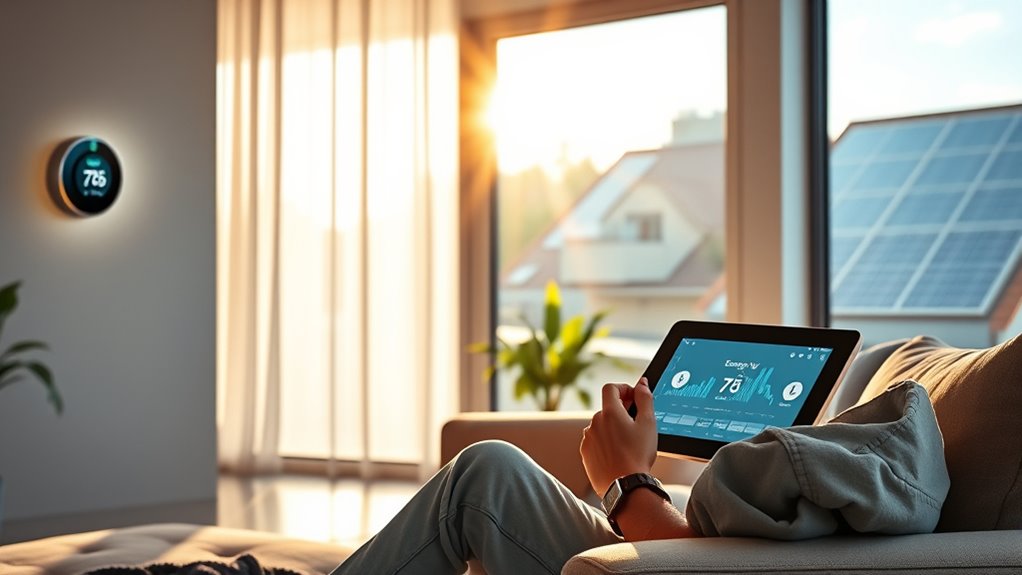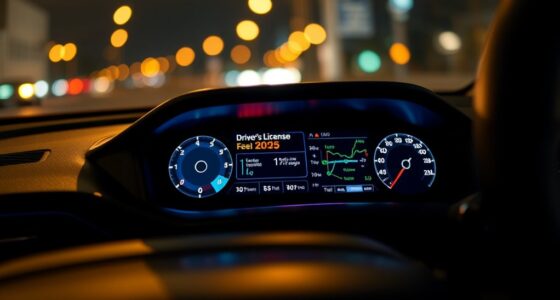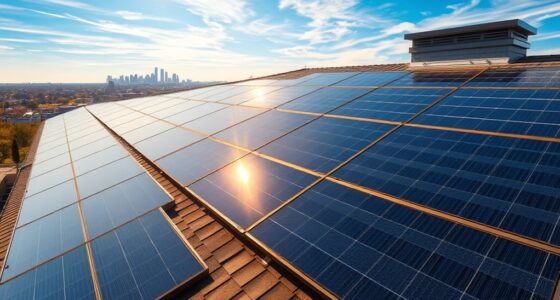To slash your power bill in 2025, focus on upgrading to LED lighting, which uses up to 75% less energy. Choose ENERGY STAR appliances to cut power use without sacrificing performance. Improve insulation and schedule regular HVAC maintenance to boost efficiency. Use smart thermostats and behavioral habits like turning off unused devices. Consider investing in solar panels with available incentives for long-term savings. Keep exploring these strategies to maximize your energy savings throughout 2025.
Key Takeaways
- Upgrade to LED lighting and install motion sensors to reduce unnecessary outdoor and indoor energy use.
- Choose ENERGY STAR-rated appliances and only run high-efficiency washers with full loads.
- Improve home insulation and regularly maintain HVAC systems for optimal energy performance.
- Use smart thermostats and turn off electronics when not in use to minimize standby power consumption.
- Invest in solar panels and leverage government incentives for long-term, sustainable energy savings.

As electricity prices continue to rise in 2025, finding ways to cut your energy costs is more important than ever. One of the simplest and most effective steps you can take is upgrading to energy-efficient lighting. Replacing traditional incandescent bulbs with LED lights reduces energy consumption considerably, often using up to 75% less energy and lasting much longer. These bulbs emit the same brightness but consume fewer kilowatt-hours, directly lowering your monthly bills. Installing motion sensors or timers for outdoor lighting ensures lights are only on when needed, further conserving energy. Small changes like switching to energy-efficient lighting may seem minor, but they add up over time, especially in homes with multiple fixtures.
Upgrade to LED lighting and use timers to cut energy costs and extend bulb life.
Another key strategy involves appliance upgrades. Older appliances tend to be energy hogs, drawing more power than their modern, energy-efficient counterparts. Upgrading to ENERGY STAR-rated appliances—such as refrigerators, dishwashers, and washing machines—can cut your energy use substantially. These appliances are designed to operate with less electricity without sacrificing performance, which means you save money on utility bills while maintaining comfort and convenience. When shopping for new appliances, look for the ENERGY STAR label, and consider your usage habits to select models that best fit your household needs. For example, using a high-efficiency washer only when full loads are ready maximizes savings. Additionally, understanding the contrast ratio of your home projector can help you choose a device that enhances your viewing experience without excessive power consumption.
Beyond lighting and appliances, other measures also contribute to reducing your electricity bill. Proper insulation and regular maintenance of your HVAC system improve efficiency, reducing cooling and heating costs, especially in regions with high regional variance like Louisiana or California. Smart home devices, such as thermostats and power strips, help you manage energy use more precisely by adjusting settings based on occupancy and time of day. Behavioral habits, like turning off electronics and lights when not in use, further trim unnecessary consumption. In fact, the HVAC system accounts for over half of total energy use in many homes, making efficient climate control a crucial part of energy savings. Investing in renewable energy sources, like solar panels, offers long-term savings and environmental benefits, supported by government incentives. Ultimately, combining these strategies—upgrading appliances, switching to energy-efficient lighting, optimizing your home’s insulation, and adopting smart habits—can help you slash your power bill and contribute to a more sustainable future.
Frequently Asked Questions
Are There Tax Incentives for Installing Solar Panels in 2025?
Yes, you can benefit from solar tax credits in 2025, which are part of renewable incentives designed to make solar installation more affordable. The federal solar tax credit offers a 30% reduction on eligible costs, including panels, inverters, and batteries. To maximize your savings, guarantee your system is installed and operational by December 31, 2025, because the incentive expires afterward. Claim the credit using IRS Form 5695 when filing your taxes.
How Can Smart Home Devices Reduce Electricity Consumption Effectively?
Smart home devices can reduce your electricity use effectively by automating lighting and optimizing your thermostat. Automated lighting with sensors turns off lights when not needed, cutting energy by up to 75%. Thermostat optimization adjusts temperatures automatically, saving you 10–15% on heating and cooling bills. When you program these devices to operate during off-peak hours and integrate them with other systems, you maximize efficiency and lower energy costs effortlessly.
What Are the Most Energy-Efficient Appliances Available Now?
You can find the most energy-efficient appliances now by looking for ENERGY STAR certified models, like Samsung’s smart refrigerators and Bosch dishwashers. These appliances use advanced technology, including inverter compressors and smart sensors, to cut energy consumption. Incorporating smart home technology further enhances efficiency by allowing you to monitor and control energy use remotely, ensuring you save on electricity while enjoying modern, eco-friendly appliances.
How Does Energy Storage Technology Impact Overall Savings?
Energy storage technology boosts your savings by enabling better battery optimization and seamless grid integration. When you store excess renewable energy, you reduce reliance on expensive peak-hour electricity, saving money over time. Plus, these systems make the grid more resilient, helping you avoid unexpected costs. As technology advances, storage becomes more efficient and scalable, ensuring you maximize your energy use and long-term savings while supporting a cleaner environment.
Will Utility Companies Offer Dynamic Pricing in 2025?
Imagine the grid as a bustling marketplace where prices dance with demand. By 2025, utility companies will likely embrace dynamic pricing, turning the traditional billing system into a responsive tool. Utility strategies will focus on real-time adjustments, encouraging smarter energy use. This shift aims to boost renewable integration, reduce costs, and give you more control over your electricity expenses. Expect your utility to offer flexible plans that adapt to the energy marketplace’s lively rhythm.
Conclusion
So, here’s the ironic twist—you’ll save so much on your power bill in 2025 that you might forget what it felt like to pay full price. While you scramble to adopt all these energy-saving tricks, the power companies may just find clever ways to keep profits high. But hey, at least you’ll enjoy the thrill of outsmarting the system, even if it means your savings are just a fleeting victory in the endless game of energy economics.










